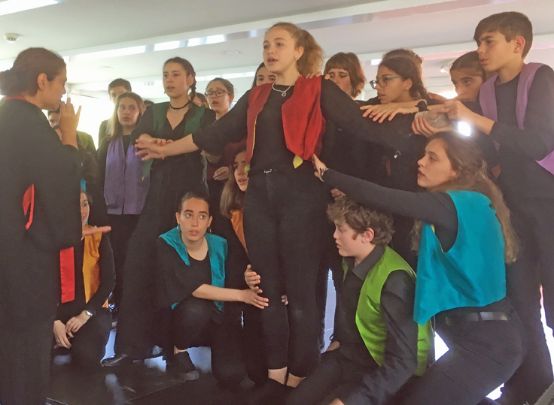Choral singing that is addictive
The 11th European Youth Choir Festival (EJCF) took place over the Ascension weekend in Basel and the surrounding region. Over five days and evenings, around 30,000 enthusiastic listeners watched the performances of over 2,000 voices from 18 guest choirs from 12 countries and a further 17 choirs.

What could be better than listening to and watching young people sing? The smile of singing touches the soul. You can't help but envy the way the young voices perform their sometimes simple, sometimes artistic songs by heart, with sophisticated gestures and facial expressions and so naturally. They fill the rooms and sing from all sides across the galleries. They walk and dance, supporting the text so that their foreign language is also understood. A choreography of singing that elevates a folk song to a Gesamtkunstwerk.
Romansh, Russian, Appenzell ...
Chara lingua della mama The girls and boys of the Bündner Incantanti choir enchant the audience with their Chantun Grischun in their native language. The dedicated director Christian Klucker cheers them on. Every syllable an inch of expression. To the song Ina dultscha melodia they form up in a circle in front of the altar of the Laufen church and let the sweet Melodia from the source of the Rhine up into the Birs valley as if on a gentle barque rocking in sound waves.
Exuberance and rigor mark the voices of the Sverdlovsk Children's Philharmonic Orchestra. Between the romantic Russians Mussorgsky and Glinka, the strapping children and young people inspire with their stomping round singing Rotola or in the whirling puppet show Balaganchik.
In the echoing Leonhard Church, the Jutz-Jugis shout the traditional Appenzell tune of Zäuerli from the Schwäbberg with the typical Alphorn-Fa, hopping in their Sennechutteli and traditional costumes, their hands in their pockets, the Reaper dance twice as lively and stretch in the Stellijuiz heads as high as the Säntis. Pure Swissness.
The Hungarian Cantemus children's choir scatters colorful sakura cherry blossoms around the church and rattles off on a cheerful sleigh ride.
A specialty of the EJCF is that the guest choirs are also invited to rehearse pieces from another choir and perform them together. For example, the Knabenkantorei Basel joins forces with the sturdy Drakensberg Boys Choir to perform the traditional Marokeni from Namibia and is infected by the temperament of the South Africans. Or the girls' choir Bat-Kol unites in the piece Hadudaim by the Israeli composer Tzvi Sherf and in a canto by Fernando Lopes-Graça with the Coro Infantil da Universidade de Lisboa. Very different temperaments come together in a foreign style and language.
Three world premieres from three parts of the country
The choral music program "Songbridge", presided over by Finnish choirmaster Kari Ala-Pöllänen, projects a modern exploration of the country in three world premieres in the beautiful Art Nouveau St. Paul's Church.
First, the Fribourg Zik'Zag-Jeunes paint in Carlo Boller's A Moléson atmospheric sounds of light from the Gruyère mountain, spurred on by Jocelyne Crausaz, followed by the chamber choir of the Gymnasium Muttenz (conductor: Jürg Siegrist) and the Grischuner Incantanti, the colorful new creation Fribourg by Fabien Volery from the baptism. In S Freikunsärt Stefan Furter takes his cue from the down-to-earth Upper Basel dialect of the peasant poet Hans Gysin, as spoken in the villages of Oltige, Weislige and Ammel at the foot of the Schafmatt. The song of the "tuusigfältige" birds has taken a liking to him. In a chorus, the woodpecker engraves Clave's field names into the trunk. A wondrous piece of nature and local history for "allergattig" voices. The Himni al sulegl by Gion Andrea Casanova from Graubünden turns out to be a hymn to the sun, to the white splendor of the snow, to cold and clouds. A sonically sparkling alternation of natural moods and emotions.
What the three world premieres have in common is that they demand a great deal of expression and affect from the voices without straining the vocal chords too much, as New Music tends to do.
The concerts conclude with the festival song Music is everywhere with the chorus, to which the audience joins in unison. The performances are celebrated with standing ovations in the packed churches and in the sold-out musical theater.
A concentrated program that lingers on
"Uff dr Stross", on five stages and squares, things get heated in the blazing sun. There is dancing and hooting, whooping and whistling, drumming and fighting until the boards on the stages bend. The director of the Coro de Jovenes de Madrid, Juan Pablo de Juan, encourages the audience to sing and clap along. The singers swing their hips as fiery carmens, courted by the young torreros. During the "Parade à l'envers", the choirs stood at the side of the street and let the audience parade past.
A new feature of this edition of the EJCF, under the proven direction of Kathrin Renggli, was a youth choir ship that cruised along the Rhine to the border triangle several times with its song-loving cargo on board - including a workshop for kids up to the age of 8.
For the 8th time, choir conductors gathered for lectures and demonstrations to prepare their youth ensembles for pop-up performances, stage presence and effective repertoire for festive appearances.
The songs of the cheerful youth resonate for a long time and bring joy and satisfaction from so much peaceful music-making across all borders. Politicians should also be taught to sing, then world peace would certainly be more possible.








